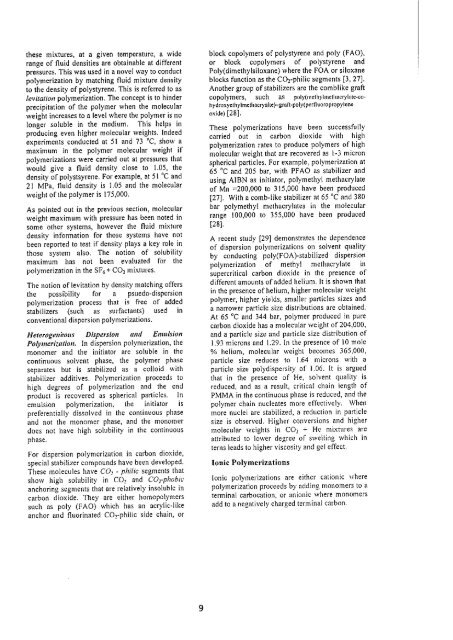March 3 - 5,1999, Karlsruhe, Germany - FZK
March 3 - 5,1999, Karlsruhe, Germany - FZK
March 3 - 5,1999, Karlsruhe, Germany - FZK
You also want an ePaper? Increase the reach of your titles
YUMPU automatically turns print PDFs into web optimized ePapers that Google loves.
these mixtures, at a given temperature, a wide<br />
range of fluid densities are obtainable at different<br />
pressures. This was used in a novel way to conduct<br />
polymerization by matching fluid mixture density<br />
to the density of polystyrene. This is referred to as<br />
levitation polymerization. The concept is to hinder<br />
precipitation of the polymer when the molecular<br />
weight increases to a level where the polymer is no<br />
longer soluble in the medium. This helps in<br />
producing even higher molecular weights. Indeed<br />
experiments conducted at 51 and 73 °C, show a<br />
maximum in the polymer molecular weight if<br />
polymerizations were carried out at pressures that<br />
would give a fluid density close to 1.05, the<br />
density of polystsyrene. For example, at 51 °C and<br />
21 MPa, fluid density is 1.05 and the molecular<br />
weight of the polymer is 175,000.<br />
As pointed out in the previous section, molecular<br />
weight maximum with pressure has been noted in<br />
some other systems, however the fluid mixture<br />
density information for those systems have not<br />
been reported to test if density plays a key role in<br />
those system also. The notion of solubility<br />
maximum has not been evaluated for the<br />
polymerization in the SF 6+ C0 2 mixtures.<br />
The notion of levitation by density matching offers<br />
the possibility for a psuedo-dispersion<br />
polymerization process that is free of added<br />
stabilizers (such as surfactants) used in<br />
conventional dispersion polymerizations.<br />
Heterogeneous Dispersion and Emulsion<br />
Polymerization. In dispersion polymerization, the<br />
monomer and the initiator are soluble in the<br />
continuous solvent phase, the polymer phase<br />
separates but is stabilized as a colloid with<br />
stabilizer additives. Polymerization proceeds to<br />
high degrees of polymerization and the end<br />
product is recovered as spherical particles. In<br />
emulsion polymerization, the initiator is<br />
preferentially dissolved in the continuous phase<br />
and not the monomer phase, and the monomer<br />
does not have high solubility in the continuous<br />
phase.<br />
For dispersion polymerization in carbon dioxide,<br />
special stabilizer compounds have been developed.<br />
These molecules have C0 2 - philic segments that<br />
show high solubility in C0 2 and CO rphobic<br />
anchoring segments that are relatively insoluble in<br />
carbon dioxide. They are either homopolymers<br />
such as poly (FAO) which has an acrylic-like<br />
anchor and fluorinated C0 2-philic side chain, or<br />
9<br />
block copolymers of polystyrene and poly (FAO),<br />
or block copolymers of polystyrene and<br />
Poly(dimethylsiloxane) where the FOA or siloxane<br />
blocks function as the C0 2-philic segments [3, 27].<br />
Another group of stabilizers are the comblike graft<br />
copolymers, such as poly(niethylmethacrylate-cohydroxyethylmcthacryalte)-graft-poly(perfluoropropylene<br />
oxide) [28].<br />
These polymerizations have been successfully<br />
carried out in carbon dioxide with high<br />
polymerization rates to produce polymers of high<br />
molecular weight that are recovered as 1-3 micron<br />
spherical particles. For example, polymerization at<br />
65 °C and 205 bar, with PFAO as stabilizer and<br />
using AIBN as initiator, polymethyl methacrylate<br />
of Mn =200,000 to 315,000 have been produced<br />
[27]. With a comb-like stabilizer at 65 °C and 380<br />
bar polymethyl methacrylates in the molecular<br />
range 100,000 to 355,000 have been produced<br />
[28].<br />
A recent study [29] demonstrates the dependence<br />
of dispersion polymerizations on solvent quality<br />
by conducting poly(FOA)-stabilized dispersion<br />
polymerization of methyl methacrylate in<br />
supercritical carbon dioxide in the presence of<br />
different amounts of added helium. It is shown that<br />
in the presence of helium, higher molecular weight<br />
polymer, higher yields, smaller particles sizes and<br />
a narrower particle size distributions are obtained.<br />
At 65 °C and 344 bar, polymer produced in pure<br />
carbon dioxide has a molecular weight of 204,000,<br />
and a particle size and particle size distribution of<br />
1.93 microns and 1.29. In the presence of 10 mole<br />
% helium, molecular weight becomes 365,000,<br />
particle size reduces to 1.64 microns with a<br />
particle size polydispersity of 1.06. It is argued<br />
that in the presence of He, solvent quality is<br />
reduced, and as a result, critical chain length of<br />
PMMA in the continuous phase is reduced, and the<br />
polymer chain nucleates more effectively. When<br />
more nuclei are stabilized, a reduction in particle<br />
size is observed. Higher conversions and higher<br />
molecular weights in C0 2 + He mixtures are<br />
attributed to lower degree of swelling which in<br />
terns leads to higher viscosity and gel effect.<br />
Ionic Polymerizations<br />
Ionic polymerizations are either cationic where<br />
polymerization proceeds by adding monomers to a<br />
terminal carbocation, or anionic where monomers<br />
add to a negatively charged terminal carbon.












![{A1[]Sp - Bibliothek](https://img.yumpu.com/21908054/1/184x260/a1sp-bibliothek.jpg?quality=85)




